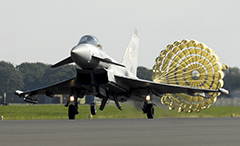Parachutes History
The modern parachute was invented in the late 18th century by Louis-Sébastien Lenormand in France, who made the first recorded public jump in 1783. Lenormand also sketched his device beforehand.
Two years later, in 1785, Lenormand coined the word "parachute" by hybridizing an Italian prefix para, an imperative form of parare = to avert, defend, resist, guard, shield or shroud, from paro = to parry, and chute, the French word for fall, to describe the aeronautical device's real function.
Also in 1785, Jean-Pierre Blanchard demonstrated it as a means of safely disembarking from a hot-air balloon. While Blanchard's first parachute demonstrations were conducted with a dog as the passenger, he later claimed to have had the opportunity to try it himself in 1793 when his hot air balloon ruptured and he used a parachute to descend (this event was not witnessed by others).
Subsequent development of the parachute focused on it becoming more compact. While the early parachutes were made of linen stretched over a wooden frame, in the late 1790s, Blanchard began making parachutes from folded silk, taking advantage of silk's strength and light weight. In 1797, André Garnerin made the first descent of a "frameless" parachute covered in silk. In 1804 Jérôme Lalande introduced a vent in the canopy to eliminate violent oscillations. More details
Two years later, in 1785, Lenormand coined the word "parachute" by hybridizing an Italian prefix para, an imperative form of parare = to avert, defend, resist, guard, shield or shroud, from paro = to parry, and chute, the French word for fall, to describe the aeronautical device's real function.
Also in 1785, Jean-Pierre Blanchard demonstrated it as a means of safely disembarking from a hot-air balloon. While Blanchard's first parachute demonstrations were conducted with a dog as the passenger, he later claimed to have had the opportunity to try it himself in 1793 when his hot air balloon ruptured and he used a parachute to descend (this event was not witnessed by others).
Subsequent development of the parachute focused on it becoming more compact. While the early parachutes were made of linen stretched over a wooden frame, in the late 1790s, Blanchard began making parachutes from folded silk, taking advantage of silk's strength and light weight. In 1797, André Garnerin made the first descent of a "frameless" parachute covered in silk. In 1804 Jérôme Lalande introduced a vent in the canopy to eliminate violent oscillations. More details

